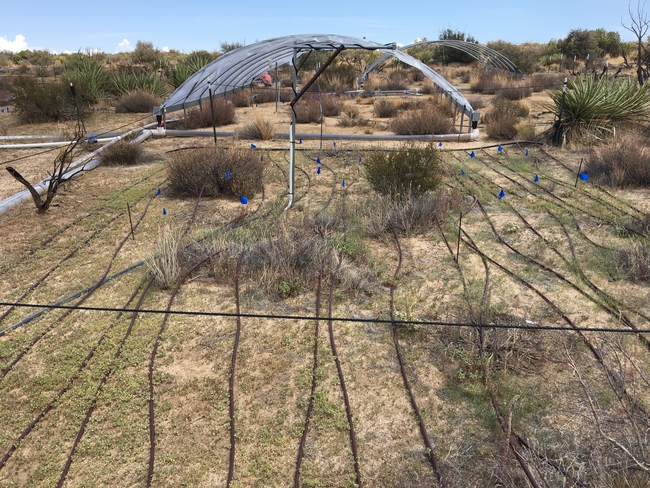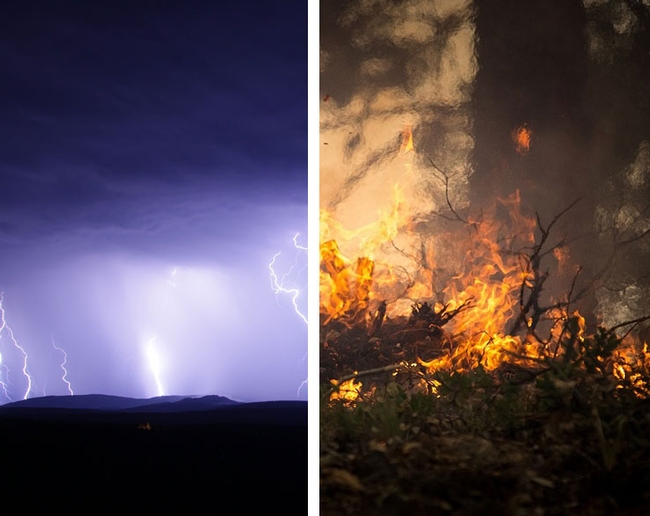Posts Tagged: rain
With dwindling water supplies, the timing of rainfall matters
How to help plants in drought-stricken states
A new UC Riverside study shows it's not how much extra water you give your plants, but when you give it that counts.
This is especially true near Palm Springs, where the research team created artificial rainfall to examine the effects on plants over the course of two years. This region has both winter and summer growing seasons, both of which are increasingly impacted by drought and, occasionally, extreme rain events.
Normally, some desert wildflowers and grasses begin growing in December, and are dead by June. A second community of plants sprouts in July and flowers in August. These include the wildflowers that make for an extremely popular tourist attraction in “super bloom” years.
“We wanted to understand whether one season is more sensitive to climate change than another,” said Marko Spasojevic, UCR plant ecologist and lead study author. “If we see an increase or decrease in summer rains, or winter rains, how does that affect the ecosystem?”
The team observed that in summer, plants grow more when given extra water, in addition to any natural rainfall. However, the same was not true in winter.
“Essentially, adding water in summer gets us more bang for our buck,” Spasojevic said.
Their findings are described in a paper published in the University of California journal Elementa.
Over the course of the study, the team observed 24 plots of land at the Boyd Deep Canyon Desert Research Center, in the Palm Desert area. Some of the plots got whatever rain naturally fell. Others were covered and allowed to receive rain only in one season. A third group of plots received additional collected rainwater.
While adding water in summer resulted in higher plant biomass, it generally did not increase the diversity of plants that grew, the researchers noted. Decreasing rainfall, in contrast, had negative effects on plants across both summer and winter, but may lead to some increased growth in the following off-seasons.
Implications of the work extend beyond learning when additional water resources might be applied simply to help plants grow. Whole communities of animals depend on these plants. They are critical for pollinators such as bees and butterflies, and they play a big role in controlling erosion and movement of soils by wind.
“Studies like this one are critical for understanding the complex effects of climate change to dryland ecosystems,” said Darrel Jenerette, UCR landscape ecologist and study co-author.
Desert plants also play an important role in removing carbon dioxide and nitrogen from the atmosphere to use as fuel for growth. Microbes that live in the soil can use the carbon and nitrogen released by plant roots, then send it back into the atmosphere where it can affect the climate.
“Drylands cover roughly a third of the land surface, so even small changes in the way they take in and emit carbon or nitrogen could have a big impact on our atmosphere,” said Peter Homyak, UCR environmental scientist and study co-author.
As the team continues this research over the next few years, they expect to see changes in soil carbon and nitrogen cycling, given that plants are already being affected by changes in seasonal rainfall, as this study shows.
“Can changes in precipitation patterns alter the feedback between plants and microbes, destabilizing the carbon locked in soils and sending more of it into the atmosphere? We are working on figuring that out,” Homyak said.
Editor's note: Jenerette and Homyak are affiliated with University of California Agriculture and Natural Resources through UC Riverside's Agricultural Experiment Station.
Did You Celebrate Happy Solstice Day?
Did you celebrate Happy Solstice Day on Dec. 21? That's the astronomical moment, according to the Farmer's Almanac, "when the Sun...
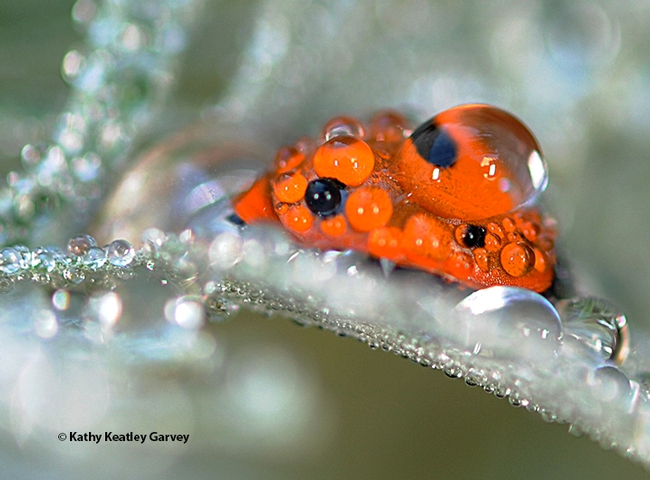
A lady beetle, aka ladybug, covered with rain droplets on Artemisia in Vacaville, Calif. (Photo by Kathy Keatley Garvey)
Precipitation and wildfire impacted by climate change
A new study out of UC Riverside projects an increase in rain and snow in California due to climate change, reported Matt Smith on Seeker.com. Anthropogenic impacts on climate are expected to produce a chronic El Niño-like weather pattern off the Pacific coast of the U.S., leading to about 12 percent more rain and snow by 2100.
The study used a newer computer model and relied on other models that have a better record of simulating precipitation and the effects of an El Niño on the state. El Niño, the cyclical warming of the Pacific Ocean near Earth's equator, typically produces warmer temperatures across much of the United States and more rainfall over California.
Meanwhile, an article by Joshua Emerson Smith in the San Diego Union-Tribune presented less-welcome climate change news. It concluded that wildfires are expected to get longer and more intense in California due to climate change.
“We will need some very new approaches to deal with both the increasing hazard of fire and our increasing exposure to it,” said Max Moritz, UC Cooperative Extension specialist in fire ecology and management at UC Berkeley's College of Natural Resources. “The situation we have created is dangerous, and without a major shift in perspective it will only get worse.”
There are ways to limit the ignition of the wildfires. The article said about 95 percent of all wildfires are caused by people, so it's important to be aware of fire-safe practices pertaining to home maintenance, campfires, target shooting, vehicle use and other outdoor activities.
Here are a few examples of fire-safe best practices:
- Mow lawns in the morning before it gets too hot. Never mow when it is windy or extremely dry. Avoid rocks when mowing; metal blades can cause sparks when they hit rocks.
- Don't drive a vehicle on dry grass or brush. Don't allow vehicle brakes to wear thin, as thin brakes can cause sparks. Carry a fire extinguisher in the car.
- Maintain 100 feet of defensible space around homes in fire-prone areas. UC ANR experts recommend a five-foot zone immediately adjacent to the home be completely devoid of plants and anything combustible.
Rain Beetles Are Curious Critters
Ah, rain! It's good for the drought and it's good for the rain beetles. If you've never seen a rain beetle (genus Pleocoma) no worries. Most people...

This rain beetle, thought to be Pleocoma fimbriata, was collected in Plymouth, Amador County. (Photo by Kathy Keatley Garvey)
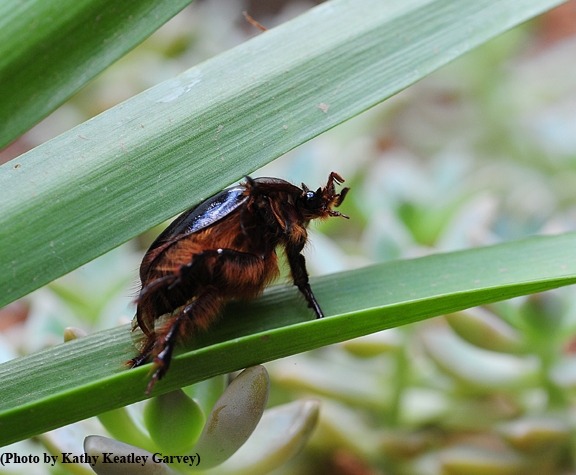
A beetle, thought to be Pleocoma fimbriata,walks on a leaf. (Photo by Kathy Keatley Garvey)

Rain beetles are large and shiny. (Photo by Kathy Keatley Garvey)

A collection of rain beetles, thought to be Pleocoma fimbriata, from Plymouth, Amador County. (Photo by Kathy Keatley Garvey)
What's That Wet Stuff?
What's that wet stuff falling from California skies? Could it be the "R" word, rain? Or what Wikipedia calls "liquid water in the form of...
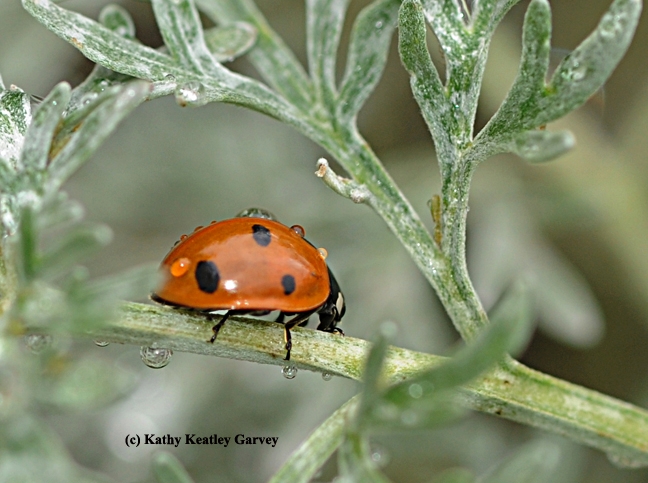
Rain drops falling on a lady beetle, aka ladybug. (Photo by Kathy Keatley Garvey)


